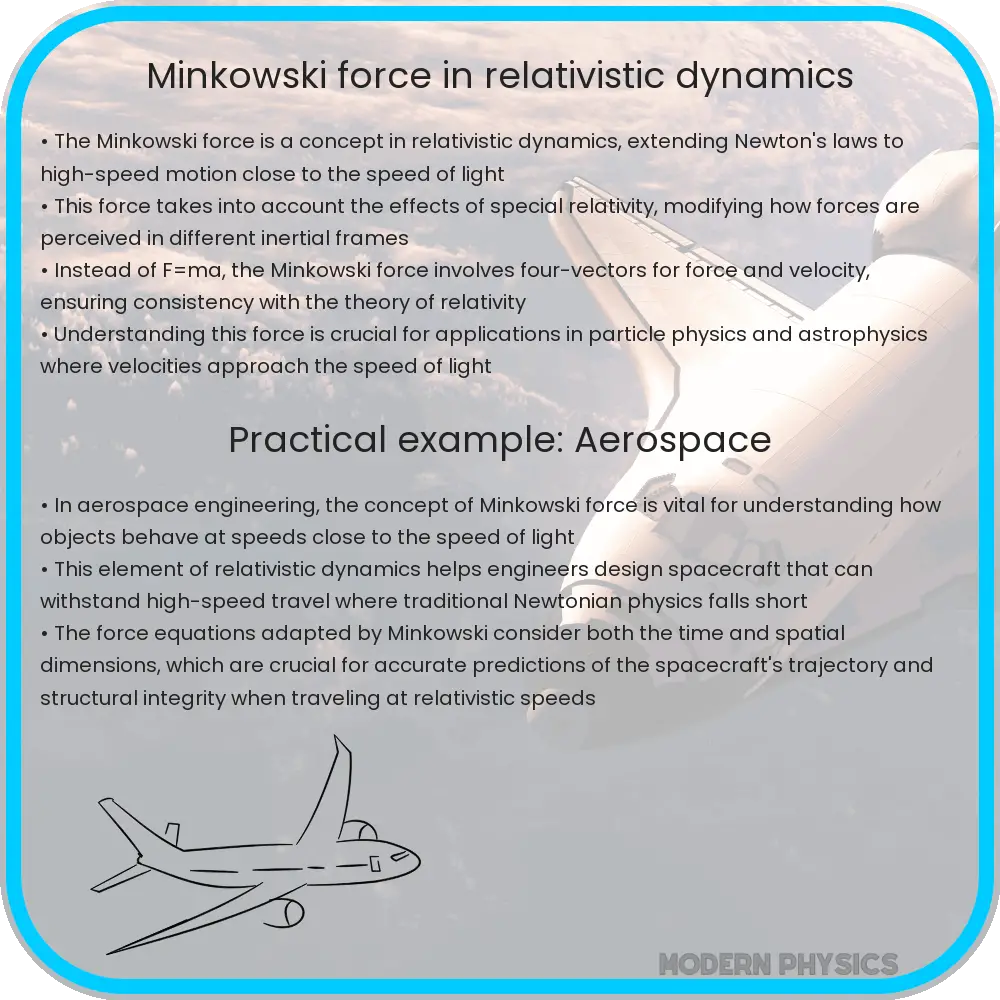Explore the role of Minkowski force in relativistic physics, covering motion, momentum, energy, and its applications in modern astrophysics and particle physics.

Understanding Minkowski Force in Relativistic Motion
The concept of Minkowski force is a fundamental aspect in the realm of relativistic physics, particularly when discussing motion, momentum, and energy. This theory extends the classical Newtonian mechanics to accommodate the effects of relativity, as proposed by Albert Einstein. To grasp the implications of Minkowski force, it is essential to first understand the basics of relativistic motion and how it differs from classical motion.
Relativistic Motion: A New Perspective
In classical mechanics, motion is described through Newton’s laws, which work well at speeds much lower than the speed of light. However, as we approach relativistic speeds – that is, speeds close to the speed of light – these laws no longer suffice. This discrepancy led to the development of Einstein’s theory of Special Relativity, which provides a more accurate description of motion at high speeds. One of the key postulates of Special Relativity is that the speed of light in a vacuum is constant and is the ultimate speed limit in the universe.
Relativistic Momentum and Energy
Under relativistic conditions, the definitions of momentum and energy undergo significant modifications. The relativistic momentum, \( p \), of an object with mass \( m \) and velocity \( v \) is given by the formula:
\[ p = \frac{mv}{\sqrt{1 – \frac{v^2}{c^2}}} \]
where \( c \) is the speed of light. This equation indicates that as an object’s velocity approaches the speed of light, its momentum tends to infinity.
Similarly, the relativistic energy, which combines the concepts of kinetic and rest energy, is expressed as:
\[ E = \sqrt{(pc)^2 + (mc^2)^2} \]
This equation reflects the famous Einstein’s mass-energy equivalence principle, \( E = mc^2 \), at rest (when \( p = 0 \)).
Minkowski Force: Bridging Force with Relativity
Minkowski force is an extension of the classical concept of force in the context of relativistic mechanics. In classical mechanics, force is the rate of change of momentum. In a relativistic framework, this definition is not straightforward due to the time dilation effect, which implies that time intervals are not absolute but depend on the observer’s frame of reference. Minkowski force is defined as the rate of change of four-momentum (a four-vector encompassing energy and momentum) with respect to proper time, the time measured by an observer moving with the object. This concept provides a consistent way to discuss forces in situations where relativistic effects are significant.
Application of Minkowski Force in Modern Physics
The application of Minkowski force is pivotal in various fields of modern physics. In particle accelerators, for instance, particles are accelerated to speeds close to the speed of light. Here, classical mechanics falls short in describing the forces acting on these particles. The Minkowski force framework offers a more accurate understanding of the dynamics of these high-speed particles.
Another critical application is in astrophysics, especially in studying phenomena involving massive celestial bodies or high velocities, such as neutron stars or black holes. The gravitational forces near these objects are so intense that relativistic effects become significant, making Minkowski force a necessary tool for analysis.
Challenges and Future Prospects
Despite its significance, the application of Minkowski force is not without challenges. The mathematics involved in relativistic mechanics is more complex than classical mechanics, requiring a deep understanding of advanced mathematical concepts. Furthermore, experimental verification of theories involving Minkowski force often demands highly sophisticated and expensive equipment, like large-scale particle accelerators or advanced telescopes.
Future prospects in this field are promising, with ongoing research focusing on deeper insights into quantum mechanics and general relativity. The integration of Minkowski force concepts with quantum field theory and the quest for a unified theory of physics are areas of intense study and hold the potential for groundbreaking discoveries.
Conclusion
The concept of Minkowski force in relativistic motion, momentum, and energy is a cornerstone in the field of modern physics. It extends the Newtonian mechanics to encompass the effects observed at relativistic speeds, thus providing a more comprehensive understanding of the universe. From particle physics to astrophysics, the implications of Minkowski force are vast and crucial. Although the complexity and the need for advanced technology pose challenges, the continuous evolution in this field promises a deeper understanding of the universe and the fundamental laws that govern it. As research progresses, Minkowski force will undoubtedly continue to play a pivotal role in the advancement of theoretical and applied physics.
